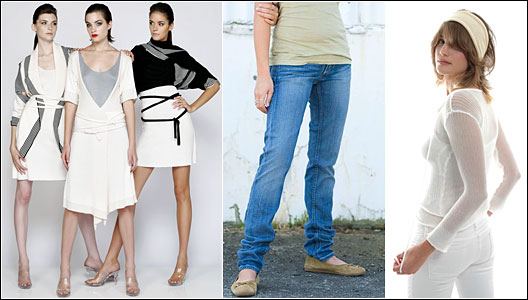If you still think eco-friendly fashion means shapeless, earth-toned duds, you’ve not yet met the 20-some designers showing their latest creations this week in Seattle. From Heatherette to Diane von Furstenberg to Oscar de la Renta, these eco-minded artisans are whipping up “fashion with a conscience” faster than you can say “green is the new black.” (And really, people, can we stop saying that altogether?)

Increasingly, clothiers are adding bamboo and other alternative fibers to their collections. Even major brands like Levi’s are offering organic cotton options. To hear the fashionistas tell it, green may soon be all there is: “Not only is there not much of a choice from the perspective of where we are environmentally,” says designer Lara Miller, “but the consumer demand is out there.”
In order to prepare for Seattle’s first-ever Green Fashion Week, I tried on all of my little black dresses caught up with three of the designers putting their eco-conscious spring collections on the runway. Each approaches the idea of green fashion from a different angle: Miller and her eponymous line focus on pieces that can be worn in a number of ways (talk about reuse!); Aiden Dinh of Sling & Stones creates premium denim products that achieve that coveted “vintage” look without the use of harmful chemicals; and Suzi Johnson of Souchi handlooms cashmere sweaters to last a lifetime.
Their experience in the fashion industry varies from fresh off the rack to old hat, but all three designers are excited to share their hopes for the future of sustainable fashion — and, in Dinh’s words, to “show people that being green doesn’t mean you gotta look like a tree.”
Lara Miller of Lara Miller
How do you incorporate sustainability into your product lines?
Ever since the beginning, I’ve been focusing on using at least some sustainable fibers. … And I always wanted to have some green practices — definitely producing in Chicago and keeping away from even looking into any overseas production.
I think it’s always important to just be honest about it; like I say in my website, it’s an aspiration toward sustainability. [I also] ensure that everything that happens — whether it’s at my cutter, or my patternmaker, or at the studio — gets recycled.
You mentioned keeping it all in Chicago; is that an effort to keep your stuff local?
If I produce in Chicago, then I can eliminate the amount of fuel and the amount of back-and-forth shipping. … Sustainability means not only being sustainable for the earth, but also being sustainable for your community. The more I can do to … sustain the community here and keep jobs here, I think it’s really important. It definitely adds to the price of my product, but every one of my labels is made in Chicago, and I’m really proud I can say that.
How do you address complaints about the higher price of green fashion?
Yeah, it’s really hard. Honestly, that question could be addressed in about a five-hour-long discussion and then could continue going on after that because it comes to so many different issues … What I’m doing [is producing] sweaters that can be worn multiple ways. The idea behind that — and from a business perspective it’s probably a really silly thing — is you have one sweater, but really within that sweater there are three different ways to wear it. You don’t need to buy as many sweaters. You’ve got your shrug, you’ve got your cardigan, and you’ve got your scarf top.
What else can people expect to see on the runway here in Seattle?
As far as fibers go, I’m still definitely focusing a lot on the handloomed bamboo sweaters, then also incorporating some organic cotton, and organic cotton with seaweed fabric (a seacell fabric), as well as the bamboo with organic cotton jersey.
What do you see ahead for the future of green fashion?
I hope that 10 years from now, there won’t even be such a thing as green fashion. And I think that we don’t have much of a choice. We really need to start being aware of everything that we do, and our clothing is just a small part of that.
Aiden Dinh of Sling & Stones
How do you incorporate sustainability into your product line?
We try to be as idealistic as possible. For Sling & Stones, our whole idea was to present our consumer with the most premium denim we could possibly make while making it as socially and ecologically responsible as we can. We try to take it further than just using certified organic cottons; we try to dye our garments with plant-based dyes, ecologically nontoxic eco dyes, or even not dye the fabric at all. In our laundering processes, we minimize water by using ozone washing, which is a process in which an ozone generator separates O3 from the air and uses it as an oxidizer to remove color from our denim (instead of using chlorine bleaches or other harmful chemicals). We also are opposed to using any sort of pumice stones in any of our garments to achieve that “vintage” worn-in look that everyone is after; instead, we hand-sand using sandpaper.
Do you see the fashion industry moving in a sustainable direction?
The industry will change when consumers begin to put their dollars into green clothing. If the industry sees that there is a desire in the market for more green fashion … then definitely, organic clothing could be sustainable. In terms of socially responsible clothes, brand owners and contractors will have to want to pay their employees fair wages, or consumers will have to want to know that their money is going back to the garment worker — and there is a lack in both, currently.
So do you see sustainable fashion as just a small niche in the market?
What we are doing is still a niche market that is growing. With the success of food markets like Trader Joe’s and Whole Foods, I think it will eventually translate from educated consumers thinking twice about what they are eating — how it was grown and who grew it — to what they are wearing, what it’s made out of, and who has sewn it.
What can we expect to see on the runway in terms of green fashion?
For this coming season, you will probably see a lot of designers offering standard organic cotton knits and wovens in basics, but you will also see a few people introducing more technical fabrics such as PLA [which is derived from cornstarch], recycled plastics turned into nylons, bamboo/cotton mixes, and bamboo denims. Many of these garments and fabrics will probably be made in China, which lacks a lot of social awareness in the garment industry. I like to remind people that it’s great to be ecologically sustainable and protect our earth, but I think it’s really just as important to be socially sustainable and protect the people living in it.
Suzi Johnson of Souchi
How do you incorporate sustainability into your product lines?
I have always relished the idea of handmade products of the finest quality. Yes, it costs more, but the quality, durability, and lifetime of the garment warrants that price. You can buy one $500 cashmere sweater that will last a lifetime or you can buy 30 sweaters at $100 a piece to last the same time. To me, it’s never been a question. There are reasons you can walk into a vintage store and buy a cashmere sweater in perfect condition from the ’50s. I don’t believe the same could be said today. But with Souchi, it will, and I hope I see them in stores when I’m in my 60s.
What do you see for the future of sustainable fashion?
I believe that sustainable fashion will continue to grow, especially among smaller labels/designers. My concern would be that mainstream or corporate-driven fashion companies are just jumping at this “trend” and not really changing practices that will better the environment, humanity, and the quality of products out there.
You use organic cotton in your pieces — what other fibers do you see becoming more mainstream as we move away from conventional cotton?
People love cotton for its softness and easy care. We need to find fibers that are just as friendly and not intimidating to mass consumers. I’m not sure we should move away from conventional cotton, but rather incorporate eco-practices in the making of cotton so that all cotton is organic. However, I do see a lot more soy, hemp, and bamboo being used, but in many cases it still lacks the softness of cotton.
What can people expect to see from you on the runway here in Seattle?
Feather-weight sheer knits in neutral colors that are meant to layer. This yarn is so amazing you won’t want to take it off!
Who else’s work are you most excited to see on the runway?
I love what Anna Cohen does. It’s beautiful, always interesting, and I think our lines work well together. I’m inspired by anyone or anything that is trying to better the planet, people’s lives, and add something more to fashion. It’s fun, it’s ridiculous, it’s silly, and it’s extravagant, but it can also be a great source of educating and enlightening people to what is available.


